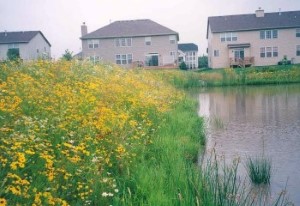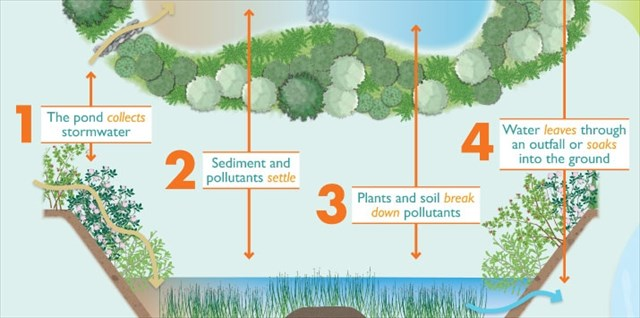Stormwater Pond Maintenance
What is a Stormwater Pond?
 Stormwater ponds are large, permanent stormwater structures that simulate the natural water cycle. They provide the capacity to store stormwater, keeping it away from our streets and homes, during storm events. The water is then slowly released, usually through an outlet structure that leads to a nearby creek or storm sewer. If the stormwater pond has no outlet structure, the excess water infiltrates into the ground or evaporates.
Stormwater ponds are large, permanent stormwater structures that simulate the natural water cycle. They provide the capacity to store stormwater, keeping it away from our streets and homes, during storm events. The water is then slowly released, usually through an outlet structure that leads to a nearby creek or storm sewer. If the stormwater pond has no outlet structure, the excess water infiltrates into the ground or evaporates.
Why are Stormwater Ponds Important?
Stormwater ponds reduce the volume and rate at which stormwater rushes into our storm sewers and rivers during a storm. This helps prevent localized flooding and downstream impacts. They also keep pollutants and sediment out of our local rivers by allowing them to settle to the bottom of the pond.

Who's Responsible for Maintaining Stormwater Ponds?
Stormwater ponds can be functional and beautiful assets in your community. They help retain stormwater after major storms and prevent polluted runoff from reaching local rivers. If not properly cared for, these ponds can become liabilities instead of assets. In most instances, the Home Owners Association (HOA) is responsible for maintaining the neighborhood's stormwater pond. Residents unsure of the maintenance responsibility of their detention facilities should check their subdivision plat and HOA declarations, or phone their HOA management company.
How Do You Maintain a Stormwater Pond?
Be proud of your pond! When stormwater ponds are neglected, they become unsightly and don’t function as they should. Consider the following actions to ensure that your stormwater pond remains healthy and helpful:
- Inspect your stormwater pond monthly. Note areas and severity of shoreline erosion and remove any foreign objects (i.e. trash, leaves) blocking inlet pipes or outlet structures.
- Contract a professional engineer to inspect your stormwater pond every one or two years. Hire a qualified contractor to perform recommended actions to ensure your pond continues to function properly.
- Discontinue application of fertilizers and pesticides around your stormwater pond. An optimal “buffer zone” width is 20’ but a commitment to discontinue use at any width is helpful.
- Consider converting the turf grass surrounding your pond to a native plant buffer zone. Work with a qualified landscape contractor to incorporate native plants to help stabilize shorelines and deter geese.
- If vegetation around your stormwater pond is over 4’ tall, you may need professional services to remove and treat for invasive species (i.e. reed canary grass and phragmites). For a free site visit, contact Jan Roehll with The Conservation Foundation at jroehll@theconservationfoundation.org or 630-428-4500, ext.121.
- Use one of the following checklists to keep track of your efforts:
Proper care and maintenance of your stormwater pond will improve neighborhood stormwater management and local water quality.
